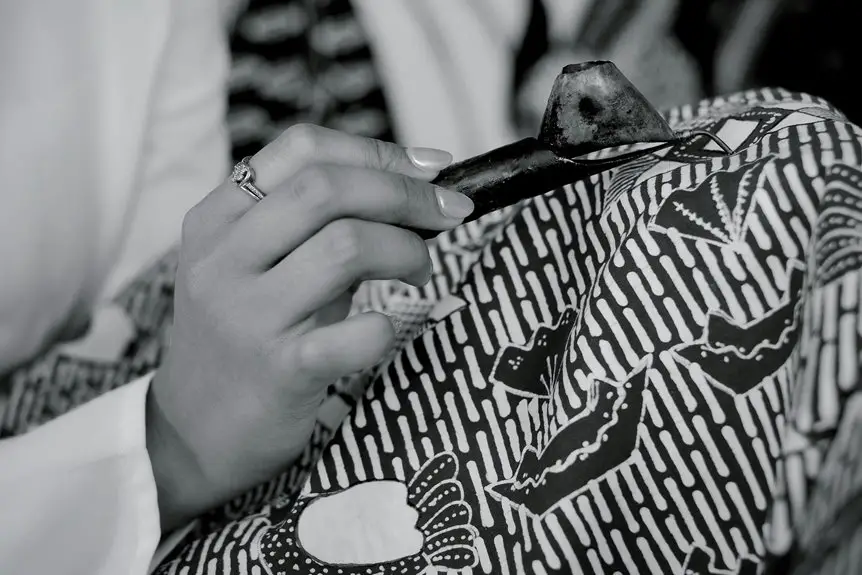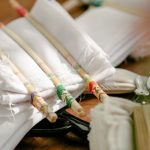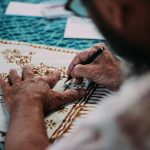You make traditional batik fabric by applying hot wax to your chosen cotton or silk material, creating intricate patterns that resist dye. You then dip the fabric into vibrant colors, repeating waxing and dyeing for multi-colored designs. Once done, you remove the wax to reveal detailed motifs reflecting cultural stories. This wax-resist method requires skill and precision with tools like a canting or copper stamp. Explore further to uncover the full creative process and cultural richness behind batik.
Table of Contents
Key Takeaways
- Traditional batik fabric is made using natural cotton or silk as the base material for vibrant dye absorption.
- Artisans sketch designs onto fabric, then apply hot wax using a canting tool or copper stamp to create wax-resist patterns.
- The fabric is dyed, with waxed areas resisting color, allowing multi-colored, intricate designs through repeated waxing and dyeing.
- Wax is removed by boiling or scraping, revealing the detailed, colorful batik patterns beneath.
- Finished batik is carefully hand washed and dried to preserve the textile’s quality and vibrant colors.
History and Cultural Significance of Batik
Although batik fabric has ancient roots, it remains a vibrant part of many cultures today. When you explore batik, you connect with a tradition that dates back thousands of years, particularly in Indonesia, Malaysia, and parts of Africa.
You’ll find that batik isn’t just about the fabric’s beauty—it’s a storytelling medium. Each pattern carries meaning, reflecting social status, regional identity, or even spiritual beliefs. As you wear or create batik, you participate in a living heritage that honors craftsmanship and cultural expression.
Over time, batik has evolved but stays deeply rooted in rituals and ceremonies. You’ll see how this art form bridges the past and present, celebrating creativity and community worldwide.
Materials and Tools Used in Batik Making
Creating authentic batik fabric depends on specific materials and tools that bring its intricate patterns to life.
You’ll start with high-quality cotton or silk fabric, which absorbs dye best and guarantees vibrant colors.
To apply wax, you’ll need a canting—a small copper or brass pen with a spout that lets you draw fine, detailed lines. For larger areas, a copper stamp called a cap helps speed up the process.
A canting draws fine wax lines, while a copper cap stamps larger patterns quickly.
Beeswax or paraffin wax mixed with resin is essential because it resists dye when applied to fabric. You’ll also need dye in various colors, usually natural or synthetic, to color your fabric after waxing.
Finally, a stove or heat source is necessary to melt and keep the wax fluid for easy application.
The Wax-Resist Dyeing Technique Explained
Once you have your fabric, wax, and tools ready, you’ll use the wax-resist dyeing technique to create batik’s signature patterns. First, you apply hot wax directly onto the fabric where you want to preserve the original color. When you dip the fabric into dye, the waxed areas resist the color, remaining unchanged. After drying, you can repeat waxing and dyeing for multi-colored designs. Finally, you remove the wax by boiling or scraping it off, revealing intricate patterns.
| Step | Description |
|---|---|
| Wax Application | Draw or stamp wax on fabric |
| Dyeing | Dip fabric into chosen dye |
| Wax Removal | Boil or scrape to remove wax |
This technique lets you control color placement with precision and creativity.
Step-by-Step Batik Fabric Production Process
Before you plunge into the intricate world of batik fabric production, it’s important to understand each step involved in transforming plain cloth into a vibrant work of art.
First, you select a natural fabric, often cotton or silk, and prepare it by washing and stretching it on a frame. Next, you sketch your design lightly onto the fabric.
Then, you apply hot wax with a canting tool or stamp to the areas you want to resist dye. After waxing, you dip the fabric into dye, allowing the color to penetrate unwaxed sections.
You repeat waxing and dyeing for multi-colored patterns. Finally, you remove the wax by boiling or scraping it off, revealing the intricate design beneath.
This careful process results in the unique beauty of traditional batik fabric.
Caring for and Preserving Batik Textiles
Although batik textiles are durable, you’ll need to handle them with care to preserve their vibrant colors and intricate patterns.
Always wash batik fabric by hand using cold water and mild detergent to prevent fading. Avoid wringing or twisting the fabric; instead, gently squeeze out excess water and lay it flat to dry away from direct sunlight.
When ironing, use a low heat setting and place a cloth between the iron and the fabric to protect the waxed areas.
Store batik textiles in a cool, dry place, preferably wrapped in breathable cotton to prevent moisture buildup.
Frequently Asked Questions
Can Batik Fabric Be Made Using Synthetic Dyes Instead of Natural Dyes?
Imagine using a smartphone in the Renaissance—synthetic dyes can replace natural ones in batik fabric, making colors brighter and lasting longer. You’ll find synthetic options more accessible and vibrant, though some prefer traditional, earthy tones.
How Long Does It Take to Complete One Piece of Traditional Batik Fabric?
It usually takes you several days to weeks to complete one piece of traditional batik fabric, depending on its size and complexity. The intricate wax application and dyeing process demand patience and careful attention to detail.
Are There Modern Machines That Can Replicate the Batik Wax-Resist Process?
Yes, you’ll find modern machines that mimic the batik wax-resist process, speeding production and ensuring consistency. However, they can’t fully capture the unique, handcrafted charm and intricate details traditional methods offer.
What Are Common Mistakes Beginners Make When Learning Batik Techniques?
You often rush the waxing process and apply too much wax, making designs muddy. You might also struggle with controlling the dye or removing wax properly. Patience and practice help you avoid these common mistakes.
How Does Climate Affect the Drying and Dyeing Process of Batik Fabric?
You’ll notice in humid climates, drying batik fabric can take twice as long, risking smudged designs. In contrast, dry heat speeds dye absorption but may cause uneven colors, so you’ll need to adjust your timing carefully.
- Does Chiffon Fabric Stink - July 15, 2025
- Does Chiffon Fabric Affect the Economy - July 15, 2025
- Does Cotton Fabric Have a Nap - July 15, 2025







